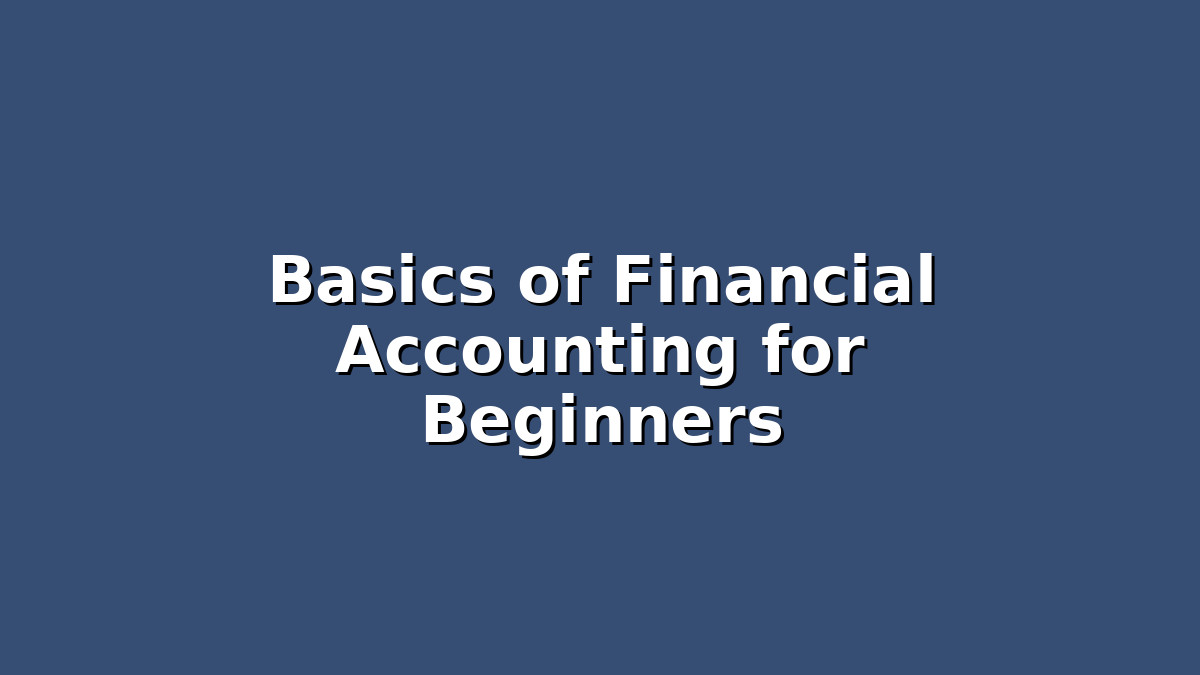Financial accounting is a fundamental subject for students pursuing business, finance, or commerce studies. Whether you’re preparing for exams or simply looking to strengthen your understanding, grasping the basics of financial accounting is essential. It not only helps you score better but also builds a strong foundation for future learning and professional success. This article will guide you through the core concepts of financial accounting and provide effective study tips to help you master the subject with confidence.
Introduction to Financial Accounting
Financial accounting is the process of recording, summarizing, and reporting a company’s financial transactions. Its main goal is to provide accurate financial information to external users such as investors, creditors, regulators, and management. Unlike managerial accounting, which is used internally, financial accounting follows standardized rules known as Generally Accepted Accounting Principles (GAAP) or International Financial Reporting Standards (IFRS), depending on your location.
For students, understanding financial accounting means becoming familiar with concepts like assets, liabilities, equity, revenues, expenses, and how these elements come together in financial statements. The key financial statements you should know are the balance sheet, income statement, and cash flow statement. These documents tell the financial story of a business and help stakeholders make informed decisions.
1. Grasping the Core Concepts: The Accounting Equation and Financial Statements
The foundation of financial accounting lies in the accounting equation:
Assets = Liabilities + Owner’s Equity
This simple equation must always be balanced and is the backbone of double-entry bookkeeping. Every transaction affects at least two accounts, ensuring the equation stays in balance.
– Assets represent what the company owns (cash, inventory, equipment).
– Liabilities reflect what the company owes (loans, accounts payable).
– Owner’s Equity is the residual interest in the assets after deducting liabilities (capital invested by owners, retained earnings).
#### Study Tip:
Create flashcards for key terms and definitions. Use diagrams to visualize the accounting equation and how transactions impact it. Repeatedly practicing journal entries will help internalize how each transaction is recorded.
Once you understand the accounting equation, move on to financial statements:
– Balance Sheet: Shows the financial position at a specific point in time.
– Income Statement: Shows profitability over a period.
– Cash Flow Statement: Shows cash inflows and outflows.
Try creating sample financial statements using fictional data to see how transactions flow through each report.
2. Mastering Journal Entries and the Double-Entry System
Accounting revolves around recording transactions using journal entries. Each entry consists of a debit and a credit, and they must balance. This double-entry system ensures accuracy and prevents errors.
For example, if a company buys equipment for cash, the equipment account (asset) increases, and cash (asset) decreases. Here, one asset increases and another decreases, maintaining the equation balance.
#### Study Tip:
Practice is critical here. Use past exam papers or online quizzes to work through various transaction scenarios. Writing down journal entries repeatedly will build your confidence. Also, try explaining the process out loud or teaching a peer; teaching is one of the most effective learning methods.
Make sure to understand common account types and their normal balances:
– Assets and expenses usually have debit balances.
– Liabilities, equity, and revenues usually have credit balances.
Knowing this helps you decide how to record transactions correctly.
3. Effective Study Techniques for Financial Accounting
Financial accounting can seem overwhelming due to its technical jargon and numerous rules. However, with the right approach, you can simplify your study process.
#### Break Down Complex Topics
Instead of trying to learn everything at once, break the syllabus into topics such as concepts, journal entries, financial statements, and adjustments. Set small goals for each study session.
#### Use Real-Life Examples
Relating accounting concepts to real-life situations makes them easier to understand and remember. For instance, think about your personal budget to understand assets and liabilities or imagine running a small business to practice recording transactions.
#### Utilize Visual Aids
Charts, mind maps, and flowcharts can help you visualize how transactions move through accounts and statements. Many students find that color-coding their notes also improves retention.
#### Practice Past Exam Questions
Past papers help familiarize you with question formats and time management. Try to simulate exam conditions when practicing to build exam stamina and reduce anxiety.
#### Join Study Groups or Forums
Collaborating with classmates or joining online study forums gives you access to different perspectives and explanations. Sometimes a peer’s way of explaining can clear up confusion quickly.
#### Don’t Ignore Theory
While calculations and journal entries are important, don’t neglect conceptual questions. Understanding why certain accounting principles exist will deepen your comprehension and help in answering theoretical questions.
Conclusion
Financial accounting is a vital skill that lays the groundwork for many career paths in business and finance. As a beginner, focus on mastering the basics: understand the accounting equation, practice journal entries diligently, and become familiar with financial statements. Combine conceptual learning with consistent practice, and use study techniques that work best for you, such as real-life application and visual aids. Remember, persistence and regular revision are keys to success.
Stay curious and patient with yourself as you learn. With the right mindset and study habits, you’ll find financial accounting not only manageable but also rewarding. Good luck with your studies and exams!

Responses